

Walk I
San Bernardino (ca. 1467)
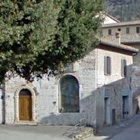
In 1410, by which time the hospital was administered by the Commune, it was ceded to the Confraternita dei Disciplinati del Crocifisso di Sant’ Agostino whose existing hospital (the Ospedale Vecchio di Sant’ Agostino) was too small for its current purpose. It was not documented thereafter and was presumably closed when the confraternity completed its new hospital.
The church that was subsequently built on the site was deconsecrated in 1788.
Crucifixion (14th century)
This fresco in a niche on the facade, which was presumably painted for the Ospedale di Umile, is attributed to Guiduccio Palmerucci.
Chiesa della Misericordia (1590)

The brothers’ oratory is reached from inside the church.
Annunciation (1655)
These altarpiece [where ?] is by/attributed to Francesco Allegrini
Frescoes (ca. 1661)
These frescoes [where ?], which are by/attributed to to Francesco Allegrini, depict:
-
✴SS Ubaldus and John the Baptist;
-
✴the Trinity; and
-
✴the Cardinal Virtues (Faith, Hope and Charity) [in the ceiling].
St Francis (18th century)
This oval panel is attributed to Gaetano Lapis.
Collegiata di Santa Cristina (1639)
This canonical community, which was established here by Giovanni Battista Cristini, was transferred:
-
✴to Santa Maria Nuova, in 1725; and
-
✴to Santa Maria dei Servi (below), in 1825.
Madonna and Child with saints (1619)
This altarpiece from Santa Cristina, which is signed by Alessandro Brunelli, was moved: to Santa Maria Nuova in 1725; and to Santa Maria dei Servi (below) in 1825. It depicts the Madonna and Child seated on a cloud with SS John the Baptist, Ubaldus, Francis and Charles Borromeo. The donor Giovanni Battista Cristini is portrayed at the lower left.
Santa Croce del Mercato (13th century)
This church, which stood in what is now Piazza 40 Martiri ( next to the pharmacy of the old hospital), belonged to the Eremo di Fonte Avellana. It was documented, together with the adjacent “Ospitale degl’ Esposti” (hospice for foundlings), from 1256. Its “domus sive palatium” (house or palace) was documented in 1290, and it was probably here that one of the itinerant proceedings against the Templars was held in 1310.
The “Spedale Grande” (great hospital), which had been built on the adjacent site in 1505, acquired the church complex in 1598. It was demolished in 1823.
Discovery of the True Cross (1562)
This altarpiece from Santa Croce del Mercato is now in the Pinacoteca Comunale. The inscription records the artist, Benedetto Nucci and the name of the Camaldolesian monk who commissioned it, Francesco Gaugello. The date was assigned the date by a local historian in the 19th century. The altarpiece depicts St Helen finding the remains of the True Cross in Jerusalem.
Baptism of Christ (ca. 1599)
This altarpiece, which is is by/attributed to Felice Damiani, was removed when the church was demolished in 1823. It was moved to Sant’ Ubaldo (in the 1st bay on the right) in the early 20th century.
San Francesco della Pace (1618)
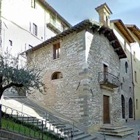
In 1871, workmen found the skeleton of a wolf nearby, and it was buried in the church.
The statues of SS Ubaldus, George and Anthony Abbot that are placed on the top of the three “ceri” for the annual Corsa dei Ceri are kept here for the rest of the year.
The inscription over the portal reads:
“d pacem largitori francisco dicatvm”
Dedicated to St Francis, the Peacemaker
[Stone that covered the entrance to the wolf’s cave]
Madonna and Child with saints (17th century)
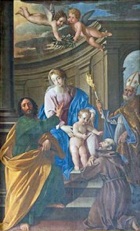
St Francis and the Wolf (1936)
This relief by Antonio Maria Rossi came from the facade.
San Francesco di Paola (1659-64)
This church was built in Palazzo Fonti by Orazio Biscaccianti della Fonte, using a bequest from his brother, Tiberio. It is dedicated to St Francis of Paola, whose rule for the new Franciscan Order of Minims had been approved in 1506. The stucco funerary monument (ca. 1664) of Tiberio and Orazio Biscaccianti della Fonte is on the counter-facade.
The church is now the headquarters of the Famiglia dei Santantoniari.
Madonna and Child with St Francis of Paola (1659)
The inscription on the back of the altarpiece on the main altar gives the name of the French artist, Simon Vaubert and the date. The inscription on the front records its commission by Tiberio and Orazio Biscaccianti della Fonte.
San Giuliano (12th century)
-
✴in 1182, Pope Lucius III confirmed the “capellam Sancti Iuliani supra portam civitatis positam” as a possession of the canons of the Duomo; and
-
✴at some in the period 1188-94, Bishop Bentivoglio confirmed the rights of the canons over “ecclesiam Sancti Iuliani positam supra murum civitatis Eugubini”.
From both of these it is clear that the church stood near a gate in the old city walls. A tract of it is apparently visible from what are now the premises of the majolica outlet of Maestro Leo Grilli at number 1, Largo del Bargello, the door of which is in the right wall of the church.
The church was extended in 1694, in a project that included the present sandstone portal.
The church passed to the Università dei Sarti (tailors’ guild) in 1714. It was subsequently allowed to fall into disrepair and is now deconsecrated.
St Ubaldus (ca. 1816)
This altarpiece by Annibale Beni, which depicts St Ubaldus in his coffin, came from San Giuliano. It is now in the Raccolta delle Memorie Ubaldiane at Sant’ Ubaldo.
Santa Maria degli Angeli (ca. 1630)

Madonna and Child with angels (17th century)
This fresco is high up on the facade.
Santa Maria dei Servi (1340-3)
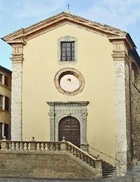
The Servites were expelled in 1810. Bishop Vincenzo Massi consecrated it in 1825 as Santa Maria Addolorata e Santa Cristina, and transferred the Collegiata di Santa Cristina (above) here from Santa Maria Nuova. This establishment was suppressed in 1860.
The façade, which is approached by a double staircase, has an elegant portal and an interesting sundial above it.
The Baroque interior has recently been restored.
The organ (1859) by Angelo and Nicolò Morettini was restored in 2008.
Altarpieces attributed to Virgilio Nucci
Three altarpieces in the church are attributed to Virgilio Nucci:
-
✴the Deposition (ca. 1610), to the left of the presbytery;
-
✴the Adoration of the Shepherds (ca. 1610), on the 1st altar on the left; and
-
✴the Annunciation (ca. 1615), on the 1st altar on the right.
Madonna and Child with saints (1619)
This altarpiece on the high altar, which is signed by Alessandro Brunelli, came from the Collegiata di Santa Cristina (above), via Santa Maria Nuova. It depicts the Madonna and Child seated on a cloud with SS John the Baptist, Ubaldus, Francis and Charles Borromeo. The donor Giovanni Battista Cristini (who founded the Collegiata di Santa Cristina) is portrayed at the lower left.
Conservatorio delle Orfanelle (ca. 1780)
This orphanage was founded in 1634 by Bishop Ulderico Carpegna, at the behest of two pious ladies: Laura Gabrielli and Angela de’ Conti Ubaldini. It was rebuilt in ca. 1780 to a design by Giuseppe Valadier.
Teatro Comunale (1713-38)
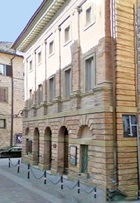
The theatre underwent a long period of restoration in 1975-85.
Walk II
San Donato alla Foce (13th century)

The adjacent monastery, which was used as a hospice after the departure of the monks, has been almost completely rebuilt. However the cloister survives.
San Felicissimo (10th century)

Madonna and Child with saints (date ?)
This altarpiece from San Felicissimo, which has recently been restored, depicts the Madonna and Child with SS Ubaldus and John the Baptist. It is now in the Raccolta delle Memorie Ubaldiane at Sant’ Ubaldo.
San Nicolò dei Cappuccini (1635-48)
A community of Capuchin friars was given the old church of San Nicolò near Sant’ Ambrogio [and/or the adjacent ex-nunnery of Santa Barbara] in 1547.
In 1634, the Commune wrote to the Provincial Minister in Spoleto seeking permission to build a new complex for them in a more convenient location. This was duly granted, and the friars walked in procession to see the site fro their new convent of 5th November, 1634. Bishop Ulderico da Carpegna laid the foundation stone in 1635. Some 20 friars moved to the new complex in 1640, albeit that the work was not completed until 1648. Bishop Averardo Sperelli consecrated the church in 1655. [His arms survive on the facade ?]
The community was suppressed in 1866. The commune opened an agricultural college here in 1878 but the site was abandoned at the end of the 19th century. The old buildings were restored and adapted for uses as a hotel in the 1960s, and now house the Park Hotel ai Cappuccini.
[Fresco (15th century) of St Christopher and the baby Jesus attributed to Ottaviano Nelli]
Excursions
San Bartolomeo (1o57)
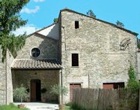
In 1063, Rudolf Gabrielli (who was then Bishop of Gubbio) arranged for Pope Alexander II to exempt San Bartolomeo from episcopal control although he safeguarded its association with Fonte Avellana.
The monastery passed to the Olivetans in 1417 and was absorbed by the Olivetans of the Abbazia di San Pietro in the 18th century. When Pope Gregory XVI suppressed the Olivetan Congregation in 1831, San Pietro passed to Fonte Avellana and, as a result, San Bartolomeo returned to its original association.
The abbey was suppressed and sold to a private owner in 1860. The church remained in use at this time, albeit that its aisles were closed. (The right aisle remains in private ownership. The campanile was destroyed in the bombardment of the Second World War.
The church, which now acts as a parish church, has a nave and two aisles, with a raised presbytery over a crypt. Its original facade has been replaced.
The monastery is in a ruinous state, although it was apparently the subject of a stalled restoration project when Bill Thayer visited in April 2004. There are some photographs and more detailed information in this page of the website Medioevo in Umbria.
Outside is a font large enough for the immersion of two people, which has been made from the sculpted fragments of a sarcophagus.
Sant’ Emiliano in Congiuntoli (11th century)

The present church (1286), which remained in use until 1860, is still well preserved. It has two naves separated by an arcade of high octagonal columns. Its frescoes (14th century) were detached in 1907 and are now preserved in the Pinacoteca at Fabriano. The remains of an earlier church (1201) and its crypt survive beside it.
The complex is open for guided visits.
San Girolamo di Monte Cucco (11th century)

A document of 1368 refers to the rebuilding of a church on the site. However, little is known about the settlement here until 1520, when the Camaldolesian reformer, the Blessed Paolo Giustiniani moved to what was then a ruined chapel here after he left Camaldoli. Papal arbitration was needed between Giustiniani and the priest at Pasciano to determine his right to stay there. Although Giustiniani stayed here for only a short while, he left a small band of followers, and San Girolamo became one of the earliest hermitages of what was to become the Congregation of Monte Corona.
Santa Maria di Sitria (11th century)
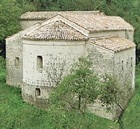
The present abbey dates to the late 12th century, although the crypt is original and uses columns that were probably carved in the 6th century. The abbey rose to prominence in the 13th century, but fell into decadence thereafter.
From 1451, it was held in commendam by Pope Nicholas V.
The community was suppressed in 1861 but has recently been revived by the monks of Fonte Avellana.
The church, which is newly restored, has a single nave and raised presbytery like that at Fonte Avellana. The altar is made up of some 14 columns. The crypt below has a vaulted roof that is supported by a single central column from a Roman building. To the side of the church is the "prigione di San Romualdo" (prison of St Romuald)where, according to tradition, the saint underwent a profound religious experience after withdrawing for a six-month period of voluntary penance in order to shame his fellow monks.
San Verecondo di Vallingegno (13th century)
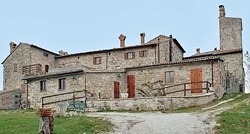
According to tradition, a church was built here over the catacombs that housed a sarcophagus with the relics of the 5th century martyr St Verecundus. It was first documented in 1131, and the crypt probably formed part of the original church. The Benedictines built the present abbey here the 13th century. The Roman sarcophagus that forms the high altar is believed to contain the relics of St Verecundus. It was probably here that St Francis stayed in 1207 when he fled from Assisi. He certainly stayed here at an uncertain date before 1220, when he famously tamed the wolf of Gubbio. The monastery was given in commendam in 1426. It is now private property.
The Ospedale di San Verecondo, which belonged to the abbey, was documented in the 14th century in what is now Via Gabrielli (see Walk I).
The adjoining castle belonged originally to the Gabrielli family. It passed to the Counts of Montefeltro along with Gubbio itself in 1384. It belonged to the Balducci family of Gubbio in the 15th and 16th centuries and to the Filippetti in the 17th century. It remains privately owned, and has been recently restored by the current owner. Its polygonal tower, which is known as the Torre di San Francesco, is particularly striking.

